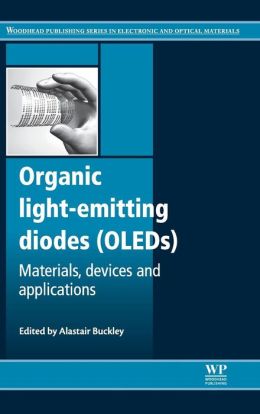 [内容简介]
[内容简介]
Organic light-emitting diodes (OLEDs) are opening up exciting new applications in the area of lighting and displays. OLEDs are self emissive and by careful materials and device design can generate colours across the visible spectrum. Together with simple monolithic fabrication on a range of different substrates, these diverse material properties give OLEDs key advantages over existing display and lighting technology. This important book summarises key research on materials, engineering and the range of applications of these versatile materials.
Part one covers materials for OLEDs. Chapters review conjugated polymers, transparent conducting thin films, iridium complexes and phosphorescent materials. Part two discusses the operation and engineering of OLED devices. Chapters discuss topics such as highly efficient pin-type OLEDs, amorphous organic semiconductors, nanostructuring techniques, light extraction, colour tuning, printing techniques, fluorenone defects and disruptive characteristics as well as durability issues. Part three explores the applications of OLEDs in displays and solid-state lighting. Applications discussed include displays, microdisplays and transparent OLEDs, sensors and large-area OLED lighting panels.
Organic light-emitting diodes (OLEDs) is a standard reference for engineers working in lighting, display technology and the consumer electronics sectors, as well as those researching OLEDs.
- Summarises key research on the materials, engineering and applications of OLEDs
- Reviews conjugated polymers, transparent conducting thin films
- Considers nanostructuring OLEDS for increasing levels of efficiency
[目录]
Part 1 Materials for organic light-emitting diodes (OLEDs): Synthesis of electroluminescent conjugated polymers for OLEDs; Transparent conducting thin films for OLEDs; Iridium and platinum complexes for OLEDs; Chemical and photophysical properties of materials for OLEDs; Phosphorescent OLEDs for solid-state lighting
Part 2 Operation and engineering of organic light-emitting diode (OLED) devices: Highly efficient pin-type OLEDs; Charge carrier mobility in amorphous organic semiconductors; Nanostructuring OLEDs to increase efficiency; Modelling of light extraction from OLEDs; Tuning the colour and efficiency of OLEDs; Optical characterisation of OLED emitters from radiation pattern analyses; Printing techniques for the fabrication of OLEDs; Fluorenone defects in fluorene-based conjugated polymers; Disruptive characteristics and lifetime issues of OLEDs
Part 3 Applications of organic light-emitting diodes (OLEDs) in displays and solid-state lighting: Active matrix, organic light-emitting diodes (AMOLEDs) for displays; The technology and manufacturing of polymer OLED on complementary metal oxide semiconductor (CMOS) microdisplays; Transparent OLED displays; OLED-based biochemical sensors; Large-area OLED lighting panels and their applications; Lifetime determination procedure for OLED lighting panels and proposal for standardisation

 新书报道
新书报道